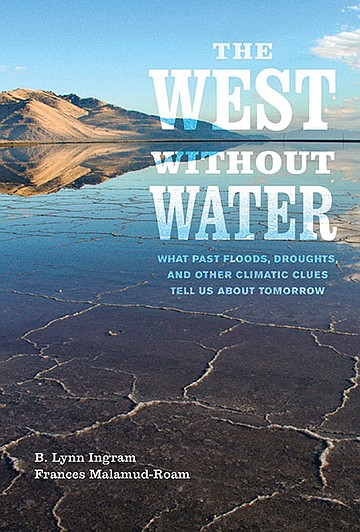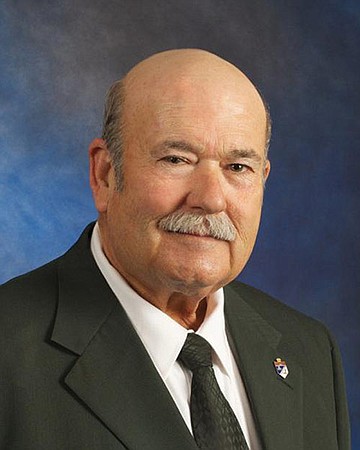 Facebook
Facebook
 X
X
 Instagram
Instagram
 TikTok
TikTok
 Youtube
Youtube

March was supposed to come in with a deluge. But populated areas got disappointingly little rain. And the rest of the month has been desert-dry. An El Niño may help later, but that’s iffy.

Maybe all Southern Californians should read the book The West Without Water, which was published by the University of California Press last August. It posits that the current drought could be worse than anything the state has suffered in centuries. The 20th Century was aberrationally wet, say the authors. Thousands of years ago, droughts could last decades, even a century. Governor Jerry Brown has warned of a “megadrought.”
As a result of a deal made in 2003, San Diego County gets 29 percent of its water from Imperial Valley, which in turn gets 100 percent of its water from the Colorado River. That river is down to a near trickle in places — suffering grievously from 14 years of drought. Imperial Valley farmers are fallowing land and are unhappy as the already-weak valley economy dips further. The nearby Salton Sea is drying up, exposing allergens that are blown throughout the area. Imperial County has the highest rate of childhood asthma in the state because of Salton Sea particulates, dust from feedlots, and other agriculture-related pollutants.
San Diego gets 46 percent of its water from Los Angeles’s Metropolitan Water District, down from 95 percent in the early 1990s. L.A.’s water district is also hit by the drought. But San Diego, Imperial, and Metropolitan all claim they have reserves that should be sufficient for this year. Most California towns are not calling for mandatory conservation measures.

That may be shortsighted. “When half of our water is dumped on lawns, people should be forced to go to desertscaping,” says Steve Erie, professor of political science at the University of California San Diego.
Others want various mandatory restrictions on consumers and businesses, and perhaps a moratorium on real estate development.

“San Diego needs to be very conscientious about development,” says Matt Dessert, a board member of the Imperial Irrigation District, which made the deal to sell water to San Diego.
Professor James Hamilton, a member of the Center for Environmental Economics at the University of California San Diego, says the San Diego County Water Authority may have to go to mandatory conservation by the summer. “We will need some better long-run solutions; it sometimes takes a crisis like this to get people focused,” he says. Still-higher prices can be one method of curtailing usage. (County usage has dropped 25 percent since 2007, as average water prices have gone up 107 percent.)

“Higher water rates reduce water usage a moderate amount over the short run and by a much larger amount over the long run,” says Professor Richard Carson of the University of California San Diego, also a member of the Center for Environmental Economics. Few changes can be made in the short term, but “in the long run, landscaping can be changed and household appliances and fixtures that use water replaced with those using less water.”

But Stuart Hurlbert, professor emeritus of biology at San Diego State University, says that initiatives like rationing and raising water prices may contribute to short-term solutions but “impede long-term solutions.” Once usage drops, developers will go right back to building homes on every available inch of land, he says. The big picture that we must focus on, says Hurlbert, is overpopulation — too many people for the amount of resources we have.
Maybe the Southwest must realize that the tremendous growth of the last half century is unsustainable.
San Diego has tentatively won the early round in a lawsuit against Metropolitan and is counting heavily on Imperial Valley for water. That could be a mistake. Marion Champion, spokeswoman for the Imperial Irrigation District, notes that Imperial farmers fallowing land is a requirement of the deal with San Diego. “It is not a popular thing; it definitely hurts our economy,” she allows. “A lot in our community want to see [the deal with San Diego] end” or be modified. Several lawsuits are pending.

San Diego “beat our ass” in negotiations, says Imperial Irrigation District board member Bruce Kuhn. “Hell no, we didn’t get a perfect deal. But warts and all…[the deal] brought some stability to an otherwise volatile situation.”
As the Salton Sea shrinks, particulates and pesticide residues blanket Imperial County. The sending of water to San Diego cuts off agricultural runoff that ordinarily would replenish the sea. Part of the 2003 deal was that the State of California would plunk $9 billion into Salton Sea restoration. “The chance of the state coming up with $9 billion is close to zero,” says Erie.
The state is “contractually obligated,” says irrigation district board member Kuhn. “If they don’t do it, they will put the entire thing in jeopardy.”
Board member Dessert warns that San Diego may have to help Imperial out financially. “It’s only natural to look to beneficiaries [such as San Diego] to step up to the plate if California doesn’t step up,” he says.
The irrigation district has launched its Salton Sea Restoration & Renewable Energy Initiative in partnership with Imperial County. The idea is to build a geothermal plant on the dry lakebed. In addition to producing energy, the plant would hold down dust at the site. There are also plans for solar electricity generation. Again, though, the State of California will be counted on to shovel in money.
Last month, the San Diego County Water Authority adopted tepid voluntary conservation steps; for example, restaurants will fill patrons’ water glasses only on request.
But face facts: your wallet is going to be emptied. “San Diego should recycle its water,” says UCSD’s Carson. “This is lower cost than desalination. Indeed, it is shocking to live in an arid area and not recycle the water.”
Desalination will go forward, as will recycling. This will cost buckets of money. Unless the drought ends, all landscape irrigation may be prohibited, car washing will be banned except at commercial car washes that recycle water, and residential and commercial construction could be curtailed. Such measures will hurt the San Diego economy. Be prepared.
Says Carson, “It is irresponsible going into a dry period to do nothing because you are not yet in serious trouble. It is better to take steps now.”


March was supposed to come in with a deluge. But populated areas got disappointingly little rain. And the rest of the month has been desert-dry. An El Niño may help later, but that’s iffy.

Maybe all Southern Californians should read the book The West Without Water, which was published by the University of California Press last August. It posits that the current drought could be worse than anything the state has suffered in centuries. The 20th Century was aberrationally wet, say the authors. Thousands of years ago, droughts could last decades, even a century. Governor Jerry Brown has warned of a “megadrought.”
As a result of a deal made in 2003, San Diego County gets 29 percent of its water from Imperial Valley, which in turn gets 100 percent of its water from the Colorado River. That river is down to a near trickle in places — suffering grievously from 14 years of drought. Imperial Valley farmers are fallowing land and are unhappy as the already-weak valley economy dips further. The nearby Salton Sea is drying up, exposing allergens that are blown throughout the area. Imperial County has the highest rate of childhood asthma in the state because of Salton Sea particulates, dust from feedlots, and other agriculture-related pollutants.
San Diego gets 46 percent of its water from Los Angeles’s Metropolitan Water District, down from 95 percent in the early 1990s. L.A.’s water district is also hit by the drought. But San Diego, Imperial, and Metropolitan all claim they have reserves that should be sufficient for this year. Most California towns are not calling for mandatory conservation measures.

That may be shortsighted. “When half of our water is dumped on lawns, people should be forced to go to desertscaping,” says Steve Erie, professor of political science at the University of California San Diego.
Others want various mandatory restrictions on consumers and businesses, and perhaps a moratorium on real estate development.

“San Diego needs to be very conscientious about development,” says Matt Dessert, a board member of the Imperial Irrigation District, which made the deal to sell water to San Diego.
Professor James Hamilton, a member of the Center for Environmental Economics at the University of California San Diego, says the San Diego County Water Authority may have to go to mandatory conservation by the summer. “We will need some better long-run solutions; it sometimes takes a crisis like this to get people focused,” he says. Still-higher prices can be one method of curtailing usage. (County usage has dropped 25 percent since 2007, as average water prices have gone up 107 percent.)

“Higher water rates reduce water usage a moderate amount over the short run and by a much larger amount over the long run,” says Professor Richard Carson of the University of California San Diego, also a member of the Center for Environmental Economics. Few changes can be made in the short term, but “in the long run, landscaping can be changed and household appliances and fixtures that use water replaced with those using less water.”

But Stuart Hurlbert, professor emeritus of biology at San Diego State University, says that initiatives like rationing and raising water prices may contribute to short-term solutions but “impede long-term solutions.” Once usage drops, developers will go right back to building homes on every available inch of land, he says. The big picture that we must focus on, says Hurlbert, is overpopulation — too many people for the amount of resources we have.
Maybe the Southwest must realize that the tremendous growth of the last half century is unsustainable.
San Diego has tentatively won the early round in a lawsuit against Metropolitan and is counting heavily on Imperial Valley for water. That could be a mistake. Marion Champion, spokeswoman for the Imperial Irrigation District, notes that Imperial farmers fallowing land is a requirement of the deal with San Diego. “It is not a popular thing; it definitely hurts our economy,” she allows. “A lot in our community want to see [the deal with San Diego] end” or be modified. Several lawsuits are pending.

San Diego “beat our ass” in negotiations, says Imperial Irrigation District board member Bruce Kuhn. “Hell no, we didn’t get a perfect deal. But warts and all…[the deal] brought some stability to an otherwise volatile situation.”
As the Salton Sea shrinks, particulates and pesticide residues blanket Imperial County. The sending of water to San Diego cuts off agricultural runoff that ordinarily would replenish the sea. Part of the 2003 deal was that the State of California would plunk $9 billion into Salton Sea restoration. “The chance of the state coming up with $9 billion is close to zero,” says Erie.
The state is “contractually obligated,” says irrigation district board member Kuhn. “If they don’t do it, they will put the entire thing in jeopardy.”
Board member Dessert warns that San Diego may have to help Imperial out financially. “It’s only natural to look to beneficiaries [such as San Diego] to step up to the plate if California doesn’t step up,” he says.
The irrigation district has launched its Salton Sea Restoration & Renewable Energy Initiative in partnership with Imperial County. The idea is to build a geothermal plant on the dry lakebed. In addition to producing energy, the plant would hold down dust at the site. There are also plans for solar electricity generation. Again, though, the State of California will be counted on to shovel in money.
Last month, the San Diego County Water Authority adopted tepid voluntary conservation steps; for example, restaurants will fill patrons’ water glasses only on request.
But face facts: your wallet is going to be emptied. “San Diego should recycle its water,” says UCSD’s Carson. “This is lower cost than desalination. Indeed, it is shocking to live in an arid area and not recycle the water.”
Desalination will go forward, as will recycling. This will cost buckets of money. Unless the drought ends, all landscape irrigation may be prohibited, car washing will be banned except at commercial car washes that recycle water, and residential and commercial construction could be curtailed. Such measures will hurt the San Diego economy. Be prepared.
Says Carson, “It is irresponsible going into a dry period to do nothing because you are not yet in serious trouble. It is better to take steps now.”
Comments